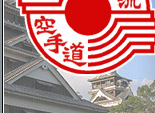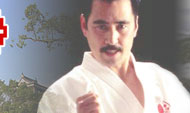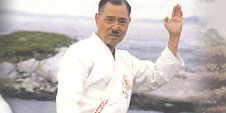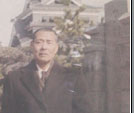What proportion of training should be dedicated to basics?
The following essay is published in whole without change and with permission from the author. It has been published in the hope that all students of Chito-Ryu (or budo in general) will continue to develop a well rounded study of the martial arts. Please note that this while this essay is while well researched and well presented, it represents an assimilation of the author's learning up to this point in his development. This essay was written as as the theory component of shodan grading.
Author - Craig Cox (2005) - Tasseikan dojo, Oatley, NSW, Australia
"Soke Sensei. Other than basics, what types of training should we be doing?" This deceptively rudimentary seeming question was asked of Chitose Tsuyoshi, Soke Sensei of Chito Ryu Karate during a question and answer session held at the 2005 karate training camp by a senior kyu grade student. Soke Sensei’s answer, which will be shared later, displayed an economy and elegance that was profound in spite of the brevity with which it was expressed. Indeed, what proportion of one’s training should be dedicated to the practice of basics? The question itself has great merit and deserves serious contemplation by serious budoka regardless of the martial art being studied. By the conclusion of this paper, we shall have a much greater understanding of the importance of this vital yet commonly neglected aspect of martial study and the wider relevance of strong basics to the general lives of all.
"Basics" is the common English translation of the Japanese expression kihon 基本, however, this oversimplified definition suffers a distinctly Western loading, as we shall see. Such oversimplification is a direct result of the frequent misconception that for all lexis and expression within a foreign language, a literally direct match also exists within one’s native tongue. As martial artists, we regularly encounter Japanese expressions that have highly specialised definitions or culturally specific applications. Despite this, very few individuals question whether or not equivalent expressions exist within our own language to communicate effectively the intended meaning of the original. Actually, the vast majority are unaware that such incongruence exists between languages. Such being the case, it is extremely relevant, even necessary that in order to progress in our martial studies, we are mindful of the importance to appreciate fully the possible range of connotation one may apply to these extremely interesting expressions.
Kihon 基本 exists in Japanese as an idiomatic compound expression, that is, it is a word composed of two or more Chinese characters. Let us first investigate fully the meaning of each component character in order to begin to understand the meaning and relevance of basics;
The character, Ki 基, means broadly:...foundation; fundamentals; basis to govern oneself.
Interestingly, the same character can also be read as Moto, meaning basis, foundation, origin. Alternatively, the verb reading Motozuku 基ずく also exists, meaning:...be based on, be founded on...1
Whilst the character Hon 本, denotes: main; true; real; regular; normal.2
Now that a greater appreciation for the original expression has been recognised, before progressing any farther with our discussion, a working definition for basics as the term will be employed in the context of this paper needs to be established. Perhaps such definition seems superfluous, given that fundamentals have by convention a limited scope for variation (fundamentals are, after all, fundamentals). Non-budoka for example, could cite the basics of karate as consisting of punching, kicking, striking and blocking techniques. Both beginners and, to a lesser extent, intermediate students of karate too are likely to have little understanding as to the true nature of basics, as was evidenced by the question asked of Soke Sensei above.
It is important to recognise that ignorance with regard to basics is not a negative reflection upon a student or their teacher, rather, ignorance is little more than an indicator that the critical point from which genuine understanding of one's art has not yet been reached by the individual. Understanding is a gradual process that must be experienced for oneself in order to be truly appreciated, hence the necessity for the individual to train by themselves. One cannot be taught to understand, requiring patient tutoring instead. However, the value of a good basics sample provided in the personage of one's seniors cannot be understated.
Vital is the recognition of the point that the word kihon in no way limits itself to the exclusive description of physical technique (as can be seen above, the composite kanji characters have no connection with matters physical in nature) in the context of karate even though karate is an obviously physical activity. For the purpose of this discussion, basics should not be taken to mean "basic technique". Contrary to common belief, strong basic techniques are NOT the goal of martial practice, though the importance of practising basic techniques must never be underestimated or ignored. There are in fact at least two types of basics that are to be practised by the budoka in order to develop oneself fully. The first of these fundamentals relates to physical development, whilst the second is concerned with character development (basics regarding matters spiritual in nature requires greater experience and is beyond the ken of the author at present).
Strong basic techniques are merely a natural by-product of committed practice to the true basics of one's martial art. To be specific, one practices basic technique in order to understand concept, not technique. Concept exists on a level more fundamental than technique and so represents the true basics that are being practised during the execution of technique. The practice of basics is done to master concept which in turn leads to superior technique. Technique then is little more than a physical expression of one's understanding of concept.
A punching technique, for example, is not mastered by repeating it countless times. One masters a punch after coming to understand the numerous concepts that combine to make a punch effective via countless repetition. This point is important to understand as all technique will by necessity vary in any number of subtle ways, being adapted by the karateka to suit the circumstances at the time of execution. The concepts of line, power, timing, speed, movement, harmony, breathing, tanden, posture etcetera NEVER vary, just as the laws of physics that govern the physical world in which we reside do not change. Change only occurs in one's level of understanding of these concept/laws.
How often should one practice basics? If one accepts that technique is the physical expression of understood concept, logically, all technique regardless of the level of expertise is an opportunity to practice basics. In this sense one is ALWAYS practising basics, at least whilst engaged in physical training. An inquisitive mind is the key point as nothing is done merely for the sake of the doing. Every action must have purpose and understanding (though the understanding is cumulative, increasing as a matter of course) otherwise valuable time and energy are wasted. Perhaps the challenge for all budoka is to stop practicing basics and start practising concept. A significant shift in mindset is required here in order to be effective.
Discussion to this point has centred upon the application and relevance of basics to physical training. However, one would be gravely mistaken to believe this to be the limit of basics to one's development, especially personal development. Funakoshi Gichin, the lauded "Father of modern karate" states clearly in his Twenty Guiding Principles of Karate, that "Karate goes beyond the dojo".3 Obviously, Funakoshi is not suggesting that one should be brawling in the streets.
What then is being alluded to by this point? In order to discuss this point one needs to accept that karate, indeed all budo disciplines, is not bound merely to the practise of physical technique and associated concepts. Basic concepts relating to character are of equal importance to the true budoka. For the practitioner of Chito Ryu, this point is reinforced by the recitation of the Showa 唱和 at the conclusion of formal training:
We who study Karate-do,
Should never forget the spirit of the samurai,
With peace, perseverance and hard work,
We will reach our goal without failure.
The Showa composed by the founder of Chito Ryu, Chitose Tsuyoshi, states clearly that the spirit of the samurai is to be observed for the serious student of karate. This so called spirit is a reference to the samurai code of behaviour known as bushido 武士道. For detailed readings on the bushido concept see the bibliography below. Briefly, bushido describes the virtues aspired to by Japan's feudal warrior caste, the samurai 侍. Drawing heavily from Zen Buddhism, Shinto and Confucian schools of thought, bushido espouses the virtues of justice, courage, benevolence, politeness, veracity, honour, loyalty, education, self control, atonement and martial skill.
Clearly, the virtues as prescribed by the bushido code relate primarily to personality. That is, bushido provides the basics necessary to build strong character and that said basics take no lesser priority than matters of a physical/technical nature. Indeed persuasive arguments can be made that due to the explicit reference to bushido in the Showa, development of the character may be the highest priority for the student of Chito Ryu. After all, what use has a modern society established upon law and order for an individual with a blistering punch but a sorely lacking personality?
What should be achieved by the practice of basics? Karateka should be mindful of the point that achievement is not so nearly as important as is purpose. The purpose of practising basics should be the development of strong personality, not strong technique. Strong technique is a natural by-product of a life spent in the rigorous yet patient pursuit of the concepts (The Way) of karate. Moreover, the term "achievement" implies that a goal is met, that perfection is possible and wholly attainable. However, in Chito Ryu, we believe that the "next level" of development always remains, implying that the goal is never fully realised. In this sense, NOTHING is ever "achieved" and that the study of basics must continue.
Regularity of practice presents an interesting conundrum for budoka. Naturally, physical concepts as expressed via technique should be practised constantly. However, a central theme of this paper is the notion that one should NOT practice regularly per se. Rather, basics should become a practise indivisible from those fundamentals that define us as human beings. By focusing on concepts that are applicable to all aspects of our lives rather than concentrating specifically upon technique, the karateka can say truly that they practise karate, indeed, that they live karate. To live one's martial tradition twenty four hours a day, therein lays the true discipline and challenge for all martial artists.
Clearly, the issue of basics is a deceptively simple matter made unnecessarily complicated. This fact is highlighted by both the question asked of Soke Sensei above and his answer. "Soke Sensei. Other than basics, what types of training should we be doing?" To which Sensei answered "There are only basics. From basics one learns EVERYTHING."
FOOTNOTES
- Nelson, Andrew. N, The Modern Readers JAPANESE-ENGLISH CHARACTER DICTIONARY p274.
- ibid p64.
- Funakoshi, Gichin. The Twenty Guiding Principles of Karate p53.
BIBLIOGRAPHY
Nelson, Andrew. N, The Modern Readers JAPANESE-ENGLISH CHARACTER DICTIONARY
Charles E. Tuttle Co., Inc.
Tokyo, 1992.
Funakoshi, Gichin. The Twenty Guiding Principles of Karate
Kodansha International Ltd.
Tokyo, 2003.
Nitobe, Inazo, Bushido
Kodansha International Ltd.
Tokyo, 1998.
Taira, Shigesuke. Code of the Samurai
Tuttle Publishing
North Clarendon, 1999.
|



